Explain various artificialmethods of vegetative propagation.Solution in Punjabi
Artificial Methods of Vegetative Propagation. Several methods of vegetative propagation are man-made and developed by plant growers and Horticulturists for commercial production of crops. They are called artificial methods. They also include several natural methods of propagation such as use of potato tubers for growing potato crops commercially. Similarly, rhizomes of ginger, banana, bulbs of onion, sucbers of mint,etc., are artificially used for commercial production of these Bud crops. Some of the artificial methods are given below-
(a) Cuttings. The small piece of any plant organ (stem, root or leaf) used for propagation is called cutting. Leaf cuttings are used to propagate Sansevieria, Begonia, Bryophyllum and Kalanchoe. Root cuttings are used to propagate Citrus and Tamarind. Stem cuttings are most commonly used for artificial vegetative propagation. About 20-30 cm long pieces of stem are planted in the natural position in the soil for proper sprouting. Sometimes. the stem cuttings are treated with rooting hormone (IBA) for proper development of roots. Examples are plants propagated by cuttings are-Grapes Sugarcane (Fig. 1.13), Rose, Bougainvillea, Carnation, Duranta, etc.
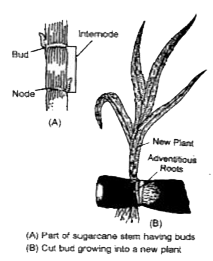
(b) Layering. In this method. roots are artificially induced on the stem branches before they are detached from the parent plant for propagation. Layering is carried out on an year old basal shoot branche commonly during early spring or early rainy season. A soft basal branch is defoliated in the middle, where a small injury or cut is given [tongueing (oblique cut), notching (V-shaped cut), ringing (removal of ring of a bark)]. The injured part is pegged in the soil to develop adventitious roots. The pegged down branch of the plam is called layer. Later on as the roots develop, the layel is separated and planted. Layering is of following types:
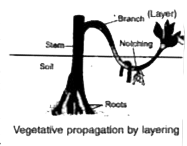
(i) Mound Layering (Fig.). The shoot is pruned and lower part is covered by soil, when a number of new shoots develop. Soil and saw dust are poured over the base to form a mound. Rooted shoots are separated and planted, e.g., Apple, Pear, Currant, Gooseberry, Jasmine, Grapevine, Strawberry, Raspberry, Cherry, etc.
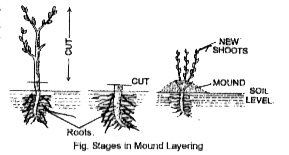
(ii) Gootee or Air Layering It is commonly used in shrubs and trees which do not have-branches near the ground. During early monsoon rains 3-5 cm long ring of bark is removed from basal region of a healthy and woody branch. It is covered by a thick plaster of grafting clay. Grafting clay is composed of 1 part cowdung, 1part finely cut hay or moss and two parts clay. To it water is added alongwith a small quantity of root promoting auxin hormones like IAA (Indole acetic acid), IBA or NAA. It is then wrapped in polythene. After 2-3 months, roots appear. The shoot is now cut below the bandage and used for planting, e.g., Pomegranate, China Rose, Orange, Guava, Lemon, Litchi, etc.

(c) Grafting. In this method parts of two closely related dicot plants having vascular cambrium are joined in snch a way that they grow as a composite plant. A small shoot of plant with superior characters is employed. It is called graft or scion. It should have one to several buds. The root system of the other plant. which is disease resistant and has good root system is allowed to remain intact. It is called stock. The shoot of the stock is of ten cut 10-30 cm above the base of the root. Cambium to cambium union is essential in between stock and scion. During grafting, stock and scion both are united by the formation of Callus. This callus is produced by cambium and this is why grafting is successful in dicots and unsuccessful in monocots as monocots do not have cambium. In grafting stock is always older than scion. Leaves and buds contained ove the stump of stock are removed. Some common examples are Mango, Apple, Citrus, Guava, Rubber Plant, Plum, Peach, Pear etc. The various methods of grafting are as follows-
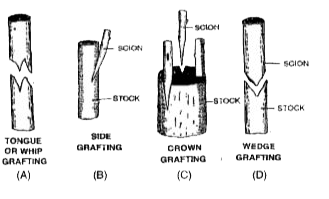
(i) Tongue Grafting. Oblique sloping cut or notch is given to both stock and scion The two perfectly . upon one another. They are tied together Stock and scion are of same diameter.
(ii) Crown Grafting. Many I scions are selected and shaped at the 1 base to form wedge. Many slits are formed on the sides of stock. Scions are inserted in the slits and bandaged. Stock has large dimeter than scion
(iii) Wedge Grafting. V-shaped notch is given to stock at one side. One end of scion is sharpened. It is inserted in the stock. Stock also has larger diameter than scion.
(d) Bud Grafting. It is done in rainy season. The scion in this case consists of a bud along with a small portion of bark having intact cambium. The living- tissue of scion bud is inserted into an incision made in the stock so that it reaches upto the cambium of stock. The bud portion should remain exposed outside in the air. The joint is thoroughly sealed using bandage. After 3-5 weaks, the bud sprouts. Then stock is cut above the level of graft, e.g., Rose, Peach, Apple. etc.
(e) Micropropagation (Propagation by Plant Tissue Culture). This method includes propagation of plants by culturing the cells, tissues and organs in nutrient medium under certain conditions called tissue culture.Initially, cells or tissues result in the formation of an undifferentiated mass of cells, called callns, which later differel).tiates to form a large number of plantlets. These plantlets are transferred to separate pots or nursery to obtain a large number of plants. Tissue culture technique is useful in obtaining virus free plants, disease free plants, homozygous diploids and in commercial micropropagation of Orchids, Gladiolus, Carnation, Chrysanthemum and other ornamental plants. This method is also used for quick multiplication of plants.
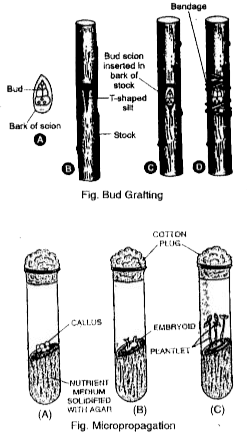
(f) Use· of Special Vegetative Organs. Some of the vegetative parts which grow natorally are also used by horticulturists for .vegetative propagation. Examples are rhizomes, tubers, suckers, stolons, corms, bulbs and bulbils.
Topper's Solved these Questions
- BOOK - BETTER CHOICE PUBLICATIONCHAPTER - REPRODUCTION IN ORGANISMSEXERCISE - SHORT ANSWER TYPE QUESTIONS (3 MARKS)13videos
REPRODUCTION IN ORGANISMS
- BOOK - BETTER CHOICE PUBLICATIONCHAPTER - PRINCIPLES OF INHERITANCE AND VARIATION EXERCISE - LONG ANSWER TYPE QUESTIONS31videos
PRINCIPLES OF INHERITANCE AND VARIATION
- BOOK - BETTER CHOICE PUBLICATIONCHAPTER - REPRODUCTIVE HEALTHEXERCISE - MOST EXPECTED QUESTIONS26videos
REPRODUCTIVE HEALTH
Similar Questions
What is fission? What is the basic difference between fission in amoeba and paramecium?
03:38View SolutionState and explain Mendel's law of independent assortment with the help of a dihybrid cross.
04:39View SolutionExpand ICSI.
01:51View SolutionExplain vegetative propagation with the help or two examples. List two advantages of vegetative propagation.
03:29View SolutionExplain about the cutting method of vegetative propagation.
02:00View SolutionName the various methods of vegetative propagation in plants.
View SolutionExplain natural vegetative propagation by roots in plants.
View SolutionWhat is vegatative propagation ? Give various natural methods of vegetative propagations in plants .
View SolutionWhat are the various methods of vegetative propagation? Discuss any one method with example.
09:33View SolutionExplain four advantages of vegetative propagation.
01:20View SolutionExplain vegetative propagation with the help of two examples. List two advantages of vegetative propagation.
03:25View SolutionDefine vegetative propagation. Explain artificial methods of vegetative propagation.
04:51View SolutionDefine: OR Explain the terms:
Vegetative propagation06:49View SolutionWhat is vegetative propagation ? Name various types of vegetative propagation.
03:15View SolutionExplain natural vegetative propagation by roots in plants.
04:07View SolutionBrifely explain vegetative propagation by stems.
03:45View Solution

